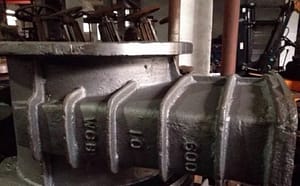Welding Quality Inspection – Sealing Test
Welding quality inspection refers to the inspection of welding results to ensure the integrity, reliability, safety and usability of the welding structure. In addition to the requirements of welding technology and welding process, welding quality inspection is also an important part of welding structure quality management.

This time we talk about the welding quality inspection method: sealing test.
So how to detect the sealing of welded joint?
In general, the following methods can be used for testing:
1. Submergence test
Used for small vessels or pipes subject to less internal pressure. The vessel or pipe is filled with a Compressed air of pressure (0.4-0.5 MPA) prior to inspection, and then submerged to test the tightness, such as right leakage;. This is also a common part of the bicycle tube to check if there is a leak.
2. Water holding test
The hydrostatic pressure generated by water self-weight is used to check whether there is leakage in the structure. It is mainly for visual inspection, suitable for general welding structures which are not under pressure but require sealing.
3. Ammonia leakage test
Its use is the same as the coal leakage test, and its sensitivity is higher than the kerosene leakage test. Before the test, it is easy to observe the welding line by sticking on one side a white paper or bandage soaked in 5% HGNO3, water solution or phenolphthalein reagent, the container is then filled with ammonia or a 1% nitrogen Compressed air.
If there is a leak, it will be in the white paper or bandage on a bright spot. The black spot was obtained when the solution of 5% hgno3 was soaked, and the red spot was obtained when the solution of phenolphthalein was soaked.
4. Kerosene leakage test
Used for welding structure with less internal pressure and required sealing. Kerosene permeability is strong, very suitable for weld sealing test. Before inspection, brush lime water on one side of welding seam for easy observation, and apply kerosene on the other side of welding seam after drying. The observation time was 15-30 min.
5. Helium mass spectrometry
Helium mass spectrometry is the most effective method for sealing test at present. The sensitivity of helium mass spectrometer is very high, and it can detect 10 -6 helium. Fill the vessel with helium before testing, and then detect leakage on the outside of the vessel weld. The disadvantages are the high price of helium and the long inspection period.
Although helium gas is highly penetrating, it still takes a long time to penetrate very small gaps that can not be detected by other means, and some thick-walled containers often take up to tens of hours to detect leaks. Proper heating can speed up leak detection.
6. Air tightness test
Air tightness test is a routine inspection method for boiler, pressure vessel and other important welding structures requiring air tightness. Medium for clean air, test pressure is generally equal to the design pressure. The pressure should be increased step by step during the test.
When the design pressure is reached, the outer side of the weld or sealing surface is coated with soapy water and the soapy water bubbling is taken as the test basis. Because the air tightness test has explosion danger, therefore should carry on after the hydraulic pressure test qualified.
The air tightness test is not the same as the air pressure test:
a. The air tightness test is to check the tightness of the pressure vessel, and the air pressure test is to check the pressure strength of the pressure vessel. Secondly, the test pressure is different, the air tightness test pressure is the design pressure of the vessel, the air pressure test pressure is 1.15 times of the design pressure.
The air pressure test is mainly for checking the strength and tightness of the equipment, and the air tightness test is mainly for checking the tightness of the equipment, especially for the small penetrating defects, the air pressure test focuses on the overall strength of the equipment.
b. Use the medium
Air pressure test is generally used in actual operation, air tightness test in addition to air, if the medium is more toxic, do not allow leakage or easy penetration, using ammonia, halogen or helium
c. Safety accessories
Air pressure test, do not need to install safety accessories on the equipment; air tightness test generally installed in the safety accessories can be carried out (volume gauge) .
d. Order
Air tightness test shall be carried out after completion of air or water pressure test.
e. Test pressure
Air pressure test pressure is 1.15 times design pressure, internal pressure equipment also need to multiply the temperature dressing factor; air tightness test media when the test pressure for the design pressure, such as the use of other media, should also be adjusted according to the media.
f. Use occasion
Pneumatic test: hydraulic test is preferred. If hydraulic test can not be used because of the structure or support of the equipment, or if the volume of the equipment is large, the general use of pneumatic test. Air tightness test: medium is high or extremely harmful medium, or no leakage is allowed. The air pressure test belongs to the pressure test, in order to check the pressure strength of the equipment. Air tightness test belongs to tightness test, in order to test the sealing performance of equipment.
Learn more our project quality managemet, QAQC and third party inspection (TPI), NDT practices thru below link.-
https://www.jsc-safe.com/category/testing-sampling-survey/
